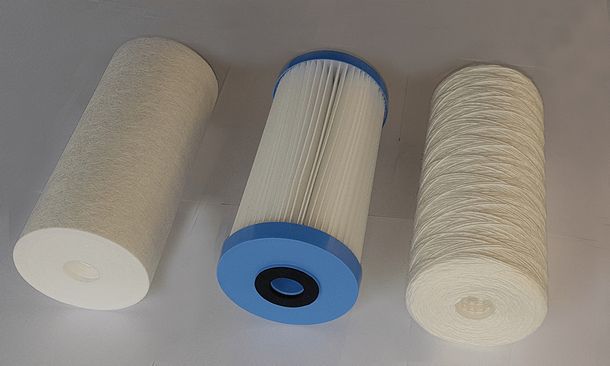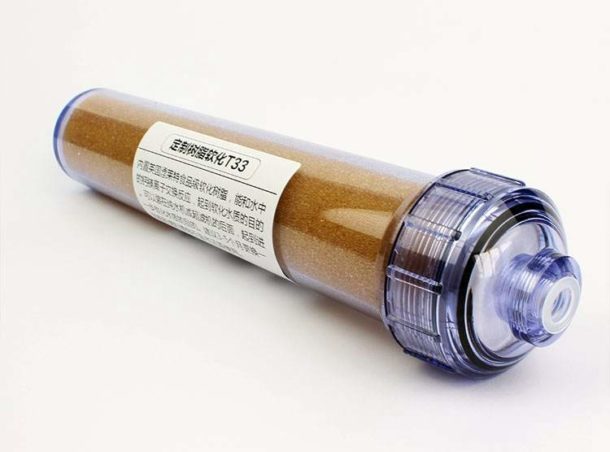Content
- Types of cartridge filters
- Mechanical filtration
- Adsorption devices
- Ion exchange cartridges
- Membrane
- Ionizers
- Which cartridges to choose?
Pure and tasty tap water in an apartment is a rarity in modern realities, so many today use water filters to clean it of impurities, harmful substances, eliminate unpleasant taste and smell. Water purification systems that make it fully drinkable typically include special cartridges, which need to be replaced as they develop their resource and which can be selected in accordance with their own needs. Let's find out what cartridges for water filters can be and how to choose them correctly.

Types of cartridge filters
Cartridges are used in three types of filters.
- Filter jug. This product uses a quick-change cartridge. The disadvantage is the small resource - from 100 to 750 liters, - which is affected by the degree of water pollution. Most often, cartridges with a coal mixture obtained from coconut shells are used here. Cartridges with an ion-exchange resin are also widely used, which reduces the hardness of water and removes heavy metal impurities from it. In water with a low fluorine content, fluorinating cartridges are used. Since only one cartridge cartridge can be installed in the jug, often these interchangeable elements comprise several components and several degrees of purification.

- Nozzle on the crane for which the suitable pressure of water is necessary. The maximum resource reaches 1,000 liters. Cartridges are installed primarily to remove chlorine and rust. There are also ion-exchange type cassettes, but their resource is extremely small and amounts to no more than 100 liters.
- Sink filter. The device requires a stationary installation and pressure from the water supply for the cleaning system. One cartridge for tap water can have a capacity of up to 15,000 liters. Here you can choose any type of cleaning, up to a cartridge with an ultrafiltration membrane. The disadvantage is the high price. Such a water filter usually contains cartridges, each of which is located in a separate flask and is responsible for one specific type of cleaning, but there are also combined products.
The difference of the filters is shown in the video:

The cartridge filters connected to the water supply have a sorbent density much higher than that of pitchers, since water passes through them under the pressure of the water supply.
And now we will consider different types of filtration and cartridges for water purification filters.
USEFUL INFORMATION:Replacing reverse osmosis filters
Mechanical filtration
The cartridge for the mechanical water purification filter contains a filter element made of a wound cord, porous polypropylene or corrugated polyester fabric. It retains mechanical impurities, sand and rust. The minimum size of the removed particles can be from 1 to 100 microns. Cartridge for water filter must not pass suspensions exceeding 1 micron or 5 microns in size.
Mechanical filtration is preliminary, and is applied before other methods, so that the resource of fine filters is longer. Garbage accumulates inside, adversely affecting throughput. For corrugated cartridges, debris can be removed by periodic washing, other types of cartridges are not washed and must be replaced. Such cartridges for water treatment are used for approximately 6 months, after which they must be replaced.

Such filters are used in instant drinking filter Atoll D-31si STD

It is recommended to use the following options of replaceable filtering elements:
- 1st stage: P5 mechanical prefilter (5 microns) for removing mechanical impurities larger than 5 microns.
- 2nd stage: Atoll RF-10 iron remover - to remove dissolved and oxidized iron, as well as reduce odors associated with the presence of hydrogen sulfide in water
- 3rd step: Pentek TSGAC-10 carbon filter - to prevent scale formation.
If you use non-certified cartridges, as well as elements of dubious origin, you risk harming your health!
Regardless of the degree of use of the resource of individual cartridges, it is recommended in order to sanitary safety replacement of filter elements in all stages of cleaning at least 1 time in 6 months.
Adsorption devices
Due to the high porosity, adsorption replacement cartridges for water purification filters allow the liquid to be purified from organic compounds by their absorption. As a filler, zeolites, aluminosilicate, silica gel or mixtures thereof are used. The most common is activated carbon, which traps and retains harmful substances in its pores.
According to the manufacturing method, carbon cartridges are divided into:
- granular;
- pressed.
In granular (they are also called filled) water passes along the axis along the entire height of the cartridge, and not across, as in cartridges with pressed coal. This design 10 times increases the thickness of the layer of coal in contact with water, this gives more effective cleaning result, but also greater flow resistance compared to pressed coal cartridges.
USEFUL INFORMATION:How to replace the water supply in the apartment
The disadvantages of the device:
- the possibility of reverse fluid contamination if the recommended terms for replacing cartridges are not observed;
- low filtration rate.

Important! The recommended period for replacing carbon cartridges is 6 months. even if the resource is not exhausted by liters. This is because coal is a favorable environment for the development of bacteria. In order to avoid the formation of bacterial colonies on it, the carbon cartridge should be replaced at least once every 6 months.
Ion exchange cartridges
In such devices, the main profile of which is softening, backfill of granules of ion-exchange resin is used. When water passes through them, calcium and magnesium ions, which are part of hardness salts, are replaced by sodium ions. As a result, the water becomes softer.
After the resin is saturated with calcium and magnesium ions, it should be regenerated with a 10% sodium chloride solution. After the first regeneration takes place, the resource of the replaceable element is reduced by 1.5 times. With subsequent regenerations, the decrease in resource is slower.
At home, it is possible to restore performance only for collapsible cartridges. For non-separable special nozzles are produced, with the help of which it becomes possible to pass the saline solution through the device.

Membrane
If the water contains a lot of impurities, membrane cartridges are indispensable. They can be of two types: working on the principle of reverse osmosis or ultrafiltration. The first is a cartridge for producing high-quality drinking water that is similar in composition to natural rainwater or meltwater from high mountain rivers.

The membrane is the smallest sieve, where the pore size is slightly larger than the diameter of the water molecule. The latter easily seep through the membrane, and foreign impurities remain, since their size does not allow penetration through the pores.
The ultrafiltration membrane has a pore size of not more than 0.1 microns, which provides ultra-thin cleaning and disinfection of water, removing up to 99.99% of microorganisms. But at the same time, the mineral composition of the water is preserved.

The long life of the molecular membranes is ensured by the fact that they are practically not clogged, and the retained solid particles and organic substances merge into the drainage. Some membrane cartridges have a resource of 15 thousand. liters of water.
The disadvantage of a membrane cartridge is the complexity of the cleaning system and low productivity.
USEFUL INFORMATION:How to replace a cartridge in a water filter: filter maintenance, how often to change
Based cleaning reverse osmosis Now is the most effective. Bottled water is sold in stores that is purified according to this principle. The disadvantage of this method is low productivity and the high price of the cartridge. It provides a flow of 0.1 - 2 l / min. at a pressure in the water supply of 3.5 atm. It requires an additional pump and storage tank. All equipment with the filter is placed under the sink.

After purification by reverse osmosis, the demineralized composition of the water must be restored. For this, a mineralizer is used - a device with natural substances that enrich water. When using ultrafiltration membranes, this is not necessary, since after cleaning the mineral composition of the water is preserved.
Ionizers
To improve the quality of water, ionizers are used, for example, Aqualife. The water treated in this device is divided into acidic and alkaline. Alkaline ionized water has many health benefits.
The cartridge for the water ionizer is used to periodically clean the ionization chamber from salt deposits and scale, which degrade the quality of the process and can even lead to damage to the device.

Which cartridges to choose?
Replaceable cartridges for water purification filters are selected depending on its composition and the required quality. In each individual version, the service life is different and largely depends on the characteristics of the liquid being cleaned.
You can determine the cleaning method if you find out the following questions:
- The required pressure in the water supply for this filter. It is important to pay attention to the pressure of the water, the permissible values of which must be indicated in the passport.
- Cartridge throughput and compliance.
- Unit costs for water treatment. They are determined by the cost of a removable cartridge and its resource.
- Water pollution.

Rules for choosing cartridges for water filters:
- A preliminary mechanical filtration step of 1 or 5 microns is required. It is desirable to have one more strainer with a filter fineness of 10-100 microns.
- If the water contains iron, you need a special cartridge to remove it.
- Hard water is softened with the help of one or two ion-exchange elements installed after the mechanical filtration stage.
- To obtain water with high taste and remove chemical compounds always need a carbon cartridge.
- Chlorinated water is purified by two or three carbon cartridges.
- At the last stage of cleaning, a device with bactericidal additives is necessary.
- If the filter contains flasks less than the required cleaning steps, it is necessary to select combined replaceable cartridges for it.


